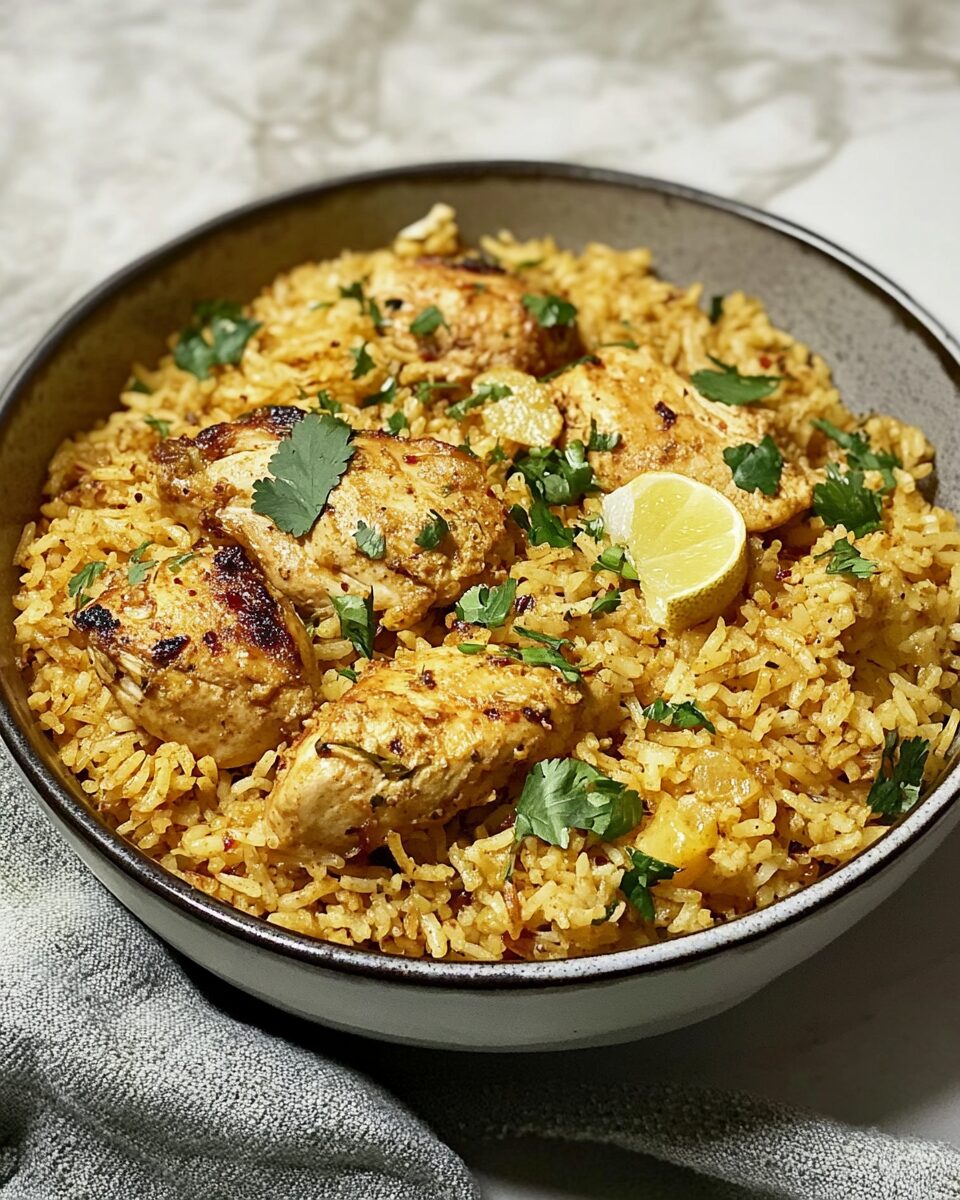Chicken Biryani is a flavorful and aromatic South Asian dish that combines basmati rice with marinated chicken and a blend of spices. Originating from the Indian subcontinent, this one-pot meal has gained popularity worldwide for its rich taste and satisfying nature. The word “biryani” is derived from the Persian word “birian,” meaning “fried” or “roasted,” reflecting the method of cooking the meat and rice together. This dish is often prepared during special occasions and gatherings, showcasing a harmonious blend of spices and ingredients.
Full Recipe:
Ingredients
- 1 pound basmati rice
- 2½ tablespoons vegetable oil
- 1 large onion, diced
- 5 pods cardamom
- 3 whole cloves
- 1-inch piece cinnamon stick
- ½ teaspoon ground ginger
- Pinch of powdered saffron
- 4 cups chicken stock
- 1½ teaspoons salt
- 3 pounds boneless, skinless chicken pieces, cut into chunks
- 2 tablespoons plain yogurt
- 2 tablespoons chopped fresh mint leaves
- ½ teaspoon ground cardamom
- 2-inch piece cinnamon stick
Directions
-
Prepare the Rice:
- Rinse the basmati rice under cold water until the water runs clear.
- Soak the rice in water for at least 30 minutes, then drain.
-
Cook the Rice:
- In a large pot, bring the chicken stock to a boil.
- Add the soaked and drained rice, cardamom pods, cloves, cinnamon stick, ground ginger, saffron, and salt.
- Cook until the rice is tender and the liquid is absorbed, about 15-20 minutes.
- Remove from heat and let it sit, covered, for 10 minutes.
-
Prepare the Chicken:
- In a large bowl, combine the chicken pieces with yogurt, chopped mint leaves, ground cardamom, and a pinch of salt.
- Mix well and marinate for at least 30 minutes, or overnight in the refrigerator for deeper flavor.
-
Cook the Chicken:
- In a large skillet, heat the vegetable oil over medium heat.
- Add the diced onion and sauté until golden brown.
- Add the marinated chicken pieces and cook until browned on all sides, about 10-15 minutes.
-
Assemble the Biryani:
- In a large serving dish, layer half of the cooked rice, followed by the cooked chicken mixture, and then the remaining rice.
- Cover and let it rest for 10 minutes to allow the flavors to meld.
-
Serve:
- Gently fluff the biryani before serving.
- Serve with raita or a side salad if desired.
Nutritional Facts
Per serving (1 serving):
- Calories: Approximately 717 kcal
- Total Fat: 26g
- Saturated Fat: 6g
- Cholesterol: 166mg
- Sodium: 1212mg
- Total Carbohydrate: 89g
- Dietary Fiber: 5g
- Sugars: 12g
- Protein: 40g
The History of Chicken Biryani
The origins of Biryani can be traced to ancient Persia, where it was originally known as “Pilaf.” Pilaf is a dish consisting of rice cooked in a seasoned broth, often served with meat. As the Persian Empire expanded, its culinary traditions began to influence the cultures it encountered. The concept of cooking rice with meat traveled through Central Asia and into India, where it became a central component of royal Mughlai cuisine.
The term “Biryani” is believed to be derived from the Persian word “birian,” which means “fried” or “roasted,” reflecting the way the meat and rice are traditionally cooked. The Mughal emperors of India, who were known for their lavish feasts, are often credited with refining and popularizing Biryani in the Indian subcontinent. It became a royal dish, with different variations emerging as the Mughal Empire expanded across India.
In India, Biryani quickly became an integral part of the culinary tradition. However, each region began to put its unique spin on the dish. In the southern city of Hyderabad, the famous Hyderabadi Biryani emerged, characterized by its layered rice and meat cooked together, along with spices like saffron. In the northern part of India, specifically in Lucknow, the Awadhi Biryani developed, with a more subtle, aromatic flavor profile. Over the years, the dish spread across the globe, becoming a popular and loved dish in not only South Asia but also in the Middle East, Southeast Asia, and parts of Europe.
Regional Variations of Chicken Biryani
While Chicken Biryani remains a consistent favorite, it is interesting to note that there are several regional variations, each with its distinct taste and preparation methods. In India, the diversity of Biryani reflects the complex regional cuisines, ingredients, and cooking styles of each area.
Hyderabadi Biryani: One of the most famous variations of Chicken Biryani, the Hyderabadi version, is known for its rich and aromatic spices, and it often uses a technique called “Dum cooking.” This method involves slow-cooking the chicken and rice together in a sealed pot, allowing the flavors to meld beautifully. The use of saffron and yogurt enhances the dish’s richness, while mint and fried onions add fresh and crispy textures. Hyderabadi Biryani is typically spicy and full of flavor, making it a favorite among those who enjoy bold dishes.
Lucknowi Biryani (Awadhi Biryani): Originating from the city of Lucknow in northern India, Lucknowi Biryani differs from the Hyderabadi version in its cooking style and flavor profile. Unlike the one-pot cooking method of the Hyderabadi style, the Lucknowi Biryani is traditionally cooked by layering the marinated chicken and partially cooked rice in a pot, which is then sealed and cooked over low heat. The meat is usually tender and mildly spiced, with the subtle use of cardamom, cloves, and cinnamon, creating a lighter and more delicate flavor compared to the Hyderabadi variant.
Kolkata Biryani: The Kolkata Biryani is a unique variation that emerged during the British colonial period. It was influenced by the royal kitchens of Awadh and brought to Kolkata (formerly Calcutta) by the Nawabs. One distinguishing feature of Kolkata Biryani is the inclusion of boiled eggs, which were added to the dish by the Nawabs as a symbol of luxury. The Kolkata Biryani is known for its milder taste and the distinct use of potatoes, which absorb the rich spices and flavors. The potatoes add a unique texture and flavor, making this version stand out.
Malabar Biryani: Hailing from the southern coastal region of Kerala, the Malabar Biryani is famous for its lighter, less spicy flavor. The rice used is often shorter-grain, and the chicken is marinated with coconut, creating a milder, creamier texture. The use of fried onions, cashews, and raisins adds a delightful sweetness to the dish, which balances the heat of the spices.
Sindhi Biryani: Popular in the Sindh region of Pakistan, Sindhi Biryani is known for its fiery spiciness and bold flavor. This variation uses a liberal amount of green chilies, yogurt, and tomatoes, giving it a tangy and spicy flavor profile. The dish is usually cooked with marinated meat and then layered with rice. It is often served with raita (yogurt sauce) to cool down the heat.
Each of these regional variations highlights the flexibility of the Chicken Biryani recipe, with unique ingredients and cooking methods that cater to local preferences and traditions. The diversity of Biryani is a testament to its enduring popularity and its ability to adapt to various culinary influences.
Why Chicken Biryani Is So Popular
Chicken Biryani’s popularity can be attributed to several key factors. First, the combination of tender chicken and fragrant rice creates a satisfying meal that can be served as a complete dish. The rich and aromatic spices used in Biryani, such as cardamom, cinnamon, cloves, and saffron, give the dish a depth of flavor that is both comforting and indulgent. The balance of spices and herbs, paired with the cooling effect of yogurt or mint, makes Biryani a harmonious blend of flavors and textures.
Secondly, Chicken Biryani is a dish that can be easily adapted to suit different tastes and dietary preferences. While the traditional version uses chicken, there are plenty of variations, including vegetarian Biryani and mutton Biryani, that cater to a wider range of people. The ability to adjust the spice levels and include different meats or vegetables allows for greater flexibility and makes Biryani a dish that can be enjoyed by almost anyone.
Another reason for the widespread popularity of Chicken Biryani is its ability to bring people together. Biryani is often served at large gatherings, feasts, and celebrations, making it a social dish that is meant to be shared. The process of preparing and serving Biryani can involve family and friends, turning the dish into a communal experience.
Moreover, Biryani has become a symbol of comfort and nostalgia for many people. It is often associated with special occasions, holidays, and home-cooked meals, creating a strong emotional connection. Whether enjoyed during a family dinner or at a wedding celebration, Chicken Biryani’s rich history and comforting flavors continue to resonate with people across generations.
Conclusion
Chicken Biryani is much more than just a meal; it is a dish steeped in history, tradition, and culture. From its origins in the royal kitchens of the Mughal Empire to its many regional variations, Chicken Biryani has become a symbol of South Asian cuisine, beloved by people all over the world. Its rich flavors, aromatic spices, and the ability to bring people together make it a dish that continues to captivate the hearts and taste buds of those who encounter it.

